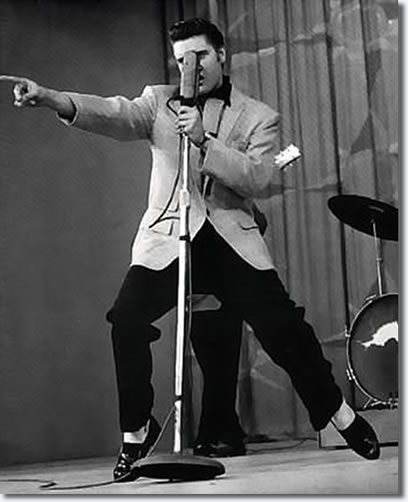
On June 5, 1956, Elvis Presley stepped onto the stage of The Milton Berle Show, ready to perform his latest single, “Hound Dog.” Little did anyone know, this performance would become one of the most talked-about moments in television history and a defining point in the evolution of rock and roll.
Presley, already a rising star, brought his signature charisma and raw energy to the stage. But it wasn’t just his voice that caught the nation’s attention—it was his hips. As the King of Rock and Roll launched into the now-iconic opening lines of “Hound Dog,” he started to move in ways that TV audiences had never seen before. His gyrating hips and suggestive dance moves caused an immediate uproar.
America, meet the pelvis. This was the moment that Elvis Presley’s name would forever be linked with controversy and innovation. In the conservative 1950s, such overt displays of sexuality were unheard of, and Presley’s performance was a bolt of lightning in the era’s cultural storm. Parents were scandalized, teenagers were electrified, and the media was ablaze with reactions both for and against this shocking display.

Ed Sullivan, the reigning king of Sunday night TV, famously declared that Elvis was “unfit for family viewing.” The backlash was swift, with critics deriding his performance as vulgar and indecent. But, as the adage goes, there’s no such thing as bad publicity. The uproar only fueled Elvis’s meteoric rise, drawing even more fans to his rebellious charm.
What many missed amid the moral panic was the sheer musical brilliance of “Hound Dog.” Originally a blues number by Big Mama Thornton, Elvis’s version transformed it into a rock and roll anthem. His snarling vocals and the driving beat captured the spirit of youthful defiance and excitement that would define the genre. This performance didn’t just break social norms; it shattered the mold of what popular music could be.
The impact of this performance on The Milton Berle Show was monumental. It signaled a shift in American culture, where rock and roll moved from the fringes to the mainstream, challenging and redefining societal norms. Teenagers saw in Elvis a figure of rebellion and freedom, someone who spoke to their desires and frustrations. For many, it was the first time they felt truly understood by a pop culture figure.
Elvis Presley’s “Hound Dog” performance was a pivotal moment not only for his career but for the entire music industry. It demonstrated the power of television as a medium for cultural change and underscored rock and roll’s ability to challenge and transform social conventions. The King’s provocative dance moves became a symbol of the burgeoning youth culture that would dominate the decades to come.
In the grand narrative of rock and roll, that night in June 1956 stands out as a milestone. It was a moment when the music didn’t just entertain—it provoked, challenged, and changed the world. Elvis’s “Hound Dog” performance was more than just a TV appearance; it was a seismic shift in American culture, heralding the arrival of a new era in music and society.
As the dust settled from the scandal, one thing was clear: Elvis Presley wasn’t just a flash in the pan. He was here to stay, and he was going to shake things up, one hip thrust at a time. This performance solidified his place as a cultural icon and paved the way for the rock and roll revolution that was about to take the world by storm. Elvis had entered the building, and nothing would ever be the same.



Leave a Reply